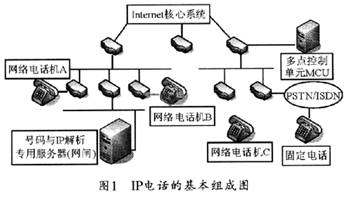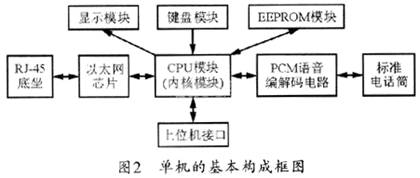The composition principle of IP telephone communication system based on SIP protocol
The composition principle of IP telephone communication system based on SIP protocol
0 Overview
IP phones have been greatly recognized by many consumers for their advantages of low call rates, convenient integration and intelligence, and thus have caused a huge impact on the long-distance calls and international telephone services of the original fixed-line operators. Therefore, with the direct access of the Ethernet interface to the household, an IP phone with an RJ-45 Ethernet interface and directly connected to the Internet has been developed, thereby making it more convenient to use the IP telephone. With this IP phone, the user can directly dial the remote phone number, and convert the dialed phone number into the IP address of the remote IP phone through a gatekeeper, thereby establishing a call connection. In fact, the new IP telephone terminal can already directly digitize the input voice signal and follow G. 728 or G. Certain voice compression coding algorithms such as 729 complete the real-time compression of the input voice signal, reducing the bandwidth from 64 kbps to 8 kbps, thereby greatly improving the channel utilization. IP telephone terminals usually follow the SIP (or H.323) protocol, and realize the intercommunication between IP telephones and ordinary telephones through a gateway (gate way).
1 IP phone system composition
The basic principle of IP telephone communication is to use digital communication technology to perform digital compression coding on the voice signal, and then package it according to the TCP / IP standard, and then send the data packet to the receiving place through the Internet. At the same time, these voice data packets are concatenated at the receiving end. After decoding and decompression processing, to restore it to the original voice signal, so as to achieve the purpose of transmitting voice by the Internet. The basic composition principle of IP phones is shown in Figure 1. 
The IP telephone system generally has four basic components: an IP phone, a gateway, a multipoint control unit MCU (MulTIpointControl Unit), and a gatekeeper (Gatekeeper). Among them, the * machine is the client terminal of the IP phone, mostly in the form of hardware. It can be directly connected to the IP network for real-time voice or multimedia communication; the gateway is the key equipment for providing PHONE-TO-PHONE voice communication through the IP network. It is an IP network and PSTN / ISDN / PRX network interface device; the function of the multipoint control unit (MCU) is to use the IP network to realize multipoint communication, so that the IP phone can support one-to-many communication such as network conference; as for the gatekeeper , Sometimes referred to as gatekeeper or gatekeeper, is mainly used to provide management of the entire telephone system endpoints and calls.
The main functions of the gatekeeper include address translation, call admission control, call management, and call authority. At H. In the 323 proposal, the gatekeeper is an optional part, but for the actual operation of the local area network IP telephone system, the gatekeeper is an important component. In this system, the gatekeeper is set up on a terminal with an IP address. Through the gatekeeper, all terminal users' names and IP addresses can be uniformly registered and managed, and each terminal user is assigned a virtual telephone number similar to a telephone extension in advance, so that other terminal users can make calls. The calling user does not need to know the IP address of the called user's terminal, but only needs to input the corresponding virtual telephone number or real name.
2 IP phone stand-alone hardware design
IP phones are divided into receivers and callers. The end that initiates the call request is called the caller, and the other end is the receiver. According to different application scenarios, the calling party and the receiving party can switch roles, that is, either party can initiate a call request, the calling party initiates a call request and enters the receiver's IP address, and the two parties use the microphone after a successful network connection Talk to the receiver.
The main work of IP call is in the stand-alone part. With the development of ARM microprocessor technology and its maturity, the ARM9 microprocessor S3C2410 and μC / OS-II are selected to build the stand-alone part. The basic working block diagram of a general stand-alone machine is shown in Figure 2. 
In Figure 2, the CPU core module is to build a working core with CPU and memory. Among them, the microprocessor used is Samsung's S3C2410 (ARM920T), and Flash uses
It is NOR Flash of SST39VFl60 of SST company, SDRAM adopts HY57V641620HG of hynix company; Ethernet interface mainly helps CPU to finish receiving and sending TCP / IP data packet
give away. The RTL8019AS used in this design is a full-duplex plug-and-play Ethernet controller, which is compatible with RTL8019 control software and NE2000 8bit or 16bit transmission, and supports UTP,
AUI, BNC and PNP automatic detection mode, at the same time support external flash memory read and write operations and complete decoding of I / 0 port address, in addition, it also has LED indication function, its interface is in line with Ethernet2 and E802. And other standards.
The display module in the system uses an ordinary digital display LCD, which is mainly used to complete the display of phone numbers and some local working status; the keyboard module and EEPROM mainly provide network power
The dial pad of the phone to complete the dial and phone function settings. EEPROM is mainly used for setting and storage of system parameters. The voice module can use the UDAl341TS audio codec of Philips Semiconductors. In addition, the host computer interface in the system mainly completes the setting of some parameters and the reading of some already recorded parameters.
3 System software design
The work in software is mainly in the preparation of drivers, the division of tasks and the compilation of tasks. Because μC / OS-II basically does not provide an API interface library or requires additional purchase, the main driver software to be written in * includes TCP / IP, LCD driver, EEPROM driver, keyboard driver, IO driver, USB driver and other programs . The preparation of these drivers generally has fixed modes and routines. In general, IP telephony software should include all the functions needed to complete a voice call. The software can be divided into four parts as shown in Figure 3 according to function. 
3.1 Call processing module
The call processing module mainly completes the call establishment and removal functions. Call control can use SIP protocol to establish a session. In the call establishment process, a SIP terminal usually sends a call request to a local proxy server. The local proxy server queries the local redirect server to find the address of the next proxy server and forwards the call request to it. When the next proxy server receives the call request, it first searches the proxy server of the called network through the directed server, and then forwards the call request to the proxy server. After determining the called terminal, the proxy server of the called network forwards the call request to the called terminal. Finally, the called terminal answers, thereby achieving the connection.
3.2 Voice encoding / decoding module
Although the PCM coded data obtained by voice collection can provide better voice quality for long-distance communication, its rate is often too high, thus occupying too much network bandwidth resources. For this reason, it is generally necessary to further compress the voice data to reduce the rate of voice coding. In this way, correspondingly, the same decompression algorithm is needed at the receiving end to restore the original voice data. To compile this part of the code, we can use the more mature voice encoding and decoding algorithm, and make certain improvements to improve the quality of voice calls.
3.3 Data packet / unpack module
The data packaging / unpacking software module mainly packs the compressed and encoded voice data, including adding a packet header, time stamp and other information, so that it forms a voice packet. When receiving. Then the corresponding unpacking should be carried out and the voice compression package should be extracted.
3.4 Data transmission module
This module mainly completes the sending and receiving of voice packets. Because the real-time transmission of audio data to the other party is the key to ensuring real-time voice communication. Therefore, when considering reliability and real-time, we should pay more attention to speed and real-time. So when choosing a protocol, you can use the UDP protocol and use the corresponding datagram socket when programming.
4 Conclusion
The IP telephone communication system is a telephone communication system composed of existing computer network resources. It does not need to lay telephone lines and purchase telephone communication network equipment, so it can save a lot of equipment costs, line costs and engineering costs for the construction of the telephone network. When laying telephone lines, it is convenient to realize telephone communication, increase telephone users, shorten the installation engineering period, improve the utilization rate of computer network resources, expand the popularization of telephones, and at the same time increase the amount of information transmission, so it has a good social and Economic benefits.
High Frequency Ferrite Transformer,Electric Transformer,Core Type Transformer,Frequency Transformer
IHUA INDUSTRIES CO.,LTD. , https://www.ihua-magnetics.com